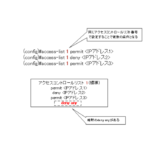目次
概要
Ciscoルータで拡張ACLによって、特定の通信のみを許可するパケットフィルタリングの設定を行います。シンプルなネットワーク構成で、設定する条件の順序や適用するインタフェースについて理解を深めましょう。
関連記事
ネットワーク構成
以下のネットワーク構成でACLを利用したパケットフィルタの設定とその動作の確認を行います。

設定条件
- ホスト3のみがWebサーバ1にHTTPでアクセスできる
- その他の通信はすべて許可する
- アクセスコントロールリストは3行で設定する
初期設定
- R1
- ホスト名/IPアドレス
- サーバ/ホスト
- ホスト名/IPアドレス/デフォルトゲートウェイ
設定と確認
Step1:アクセスコントロールリストの設定
アクセスコントロールリストの条件は、より詳細な条件から順番に設定します。Webサーバ1へのアクセスはホスト3だけに限定する条件が最も詳細なものです。そのため、まず、ホスト3からWebサーバ1へのHTTPアクセスを許可する以下の条件を設定します。
R1
access-list 100 permit tcp host 192.168.1.3 host 172.21.242.17 eq www
そして、ホスト3以外のWebサーバ1へのHTTPアクセスを拒否するための以下の条件の設定を行います。
R1
access-list 100 deny tcp any host 172.21.242.17 eq www
最後に上記以外のすべての通信を許可する条件を設定します。
R1
access-list 100 permit ip any any
ここまでの3行のアクセスコントロールリストを確認すると、以下のようになります。
R1
R1#show running-config | include access-list access-list 100 permit tcp host 192.168.1.3 host 172.21.242.17 eq www access-list 100 deny tcp any host 172.21.242.17 eq www access-list 100 permit ip any any
Step2:アクセスコントロールリストの適用
アクセスコントロールリストは作成しただけではまったく意味がありません。適切に適用しなければいけません。
Step1で作成したアクセスコントロールリストをR1のインタフェースに適用します。Fa0/0のInでもFa0/1のoutでも可能です。破棄するべきパケットはinで破棄したほうがルータのリソースの無駄を抑えることができるので、Fa0/0のInで適用します。
R1
interface FastEthernet0/0 ip access-group 100 in
Step3:アクセスコントロールリストの確認
アクセスコントロールリストの条件は、show access-listsコマンドで確認します。また、インタフェースへの適用はshow ip interface FastEthernet0/0コマンドで確認します。
R1
R1#show access-lists
Extended IP access list 100
10 permit tcp host 192.168.1.3 host 172.21.242.17 eq www
20 deny tcp any host 172.21.242.17 eq www
30 permit ip any any
R1#show ip interface FastEthernet 0/0
FastEthernet0/0 is up, line protocol is up
Internet address is 192.168.1.254/24
Broadcast address is 255.255.255.255
Address determined by setup command
MTU is 1500 bytes
Helper address is not set
Directed broadcast forwarding is disabled
Outgoing access list is not set
Inbound access list is 100
Proxy ARP is enabled
~省略~
ホスト3とそれ以外のホストからWebサーバ1へのHTTPアクセス(TCPポート80)とPingを試します。
ホスト3
H3> ping 172.21.242.17 -P 6 -p 80 Connect [email protected] timeout Connect [email protected] seq=2 ttl=63 time=15.567 ms SendData [email protected] seq=2 ttl=63 time=23.360 ms Close [email protected] seq=2 ttl=63 time=33.295 ms Connect [email protected] seq=3 ttl=63 time=17.656 ms SendData [email protected] seq=3 ttl=63 time=21.499 ms Close [email protected] seq=3 ttl=63 time=31.270 ms Connect [email protected] seq=4 ttl=63 time=17.605 ms SendData [email protected] seq=4 ttl=63 time=21.462 ms Close [email protected] seq=4 ttl=63 time=33.209 ms Connect [email protected] seq=5 ttl=63 time=16.592 ms SendData [email protected] seq=5 ttl=63 time=23.624 ms Close [email protected] seq=5 ttl=63 time=33.247 ms H3> ping 172.21.242.17 84 bytes from 172.21.242.17 icmp_seq=1 ttl=63 time=16.704 ms 84 bytes from 172.21.242.17 icmp_seq=2 ttl=63 time=21.355 ms 84 bytes from 172.21.242.17 icmp_seq=3 ttl=63 time=21.740 ms 84 bytes from 172.21.242.17 icmp_seq=4 ttl=63 time=15.768 ms 84 bytes from 172.21.242.17 icmp_seq=5 ttl=63 time=21.241 ms
ホスト1
H1> ping 172.21.242.17 -P 6 -p 80 *192.168.1.254 tcp_seq=1 ttl=255 time=11.728 ms (ICMP type:3, code:13, Communication administratively prohibited) *192.168.1.254 tcp_seq=3 ttl=255 time=3.892 ms (ICMP type:3, code:13, Communication administratively prohibited) *192.168.1.254 tcp_seq=5 ttl=255 time=5.307 ms (ICMP type:3, code:13, Communication administratively prohibited) H1> ping 172.21.242.17 84 bytes from 172.21.242.17 icmp_seq=1 ttl=63 time=14.991 ms 84 bytes from 172.21.242.17 icmp_seq=2 ttl=63 time=16.779 ms 84 bytes from 172.21.242.17 icmp_seq=3 ttl=63 time=16.879 ms 84 bytes from 172.21.242.17 icmp_seq=4 ttl=63 time=18.850 ms 84 bytes from 172.21.242.17 icmp_seq=5 ttl=63 time=16.017 ms
ホスト3からはWebサーバ1へのHTTPアクセスが可能です。Pingの応答も返ってきます。一方、ホスト1からWebサーバ1へは、Pingの応答は返ってくるもののHTTPアクセスはできないことがわかります。
そして、R1でshow access-listsコマンドを見ると、以下のように各条件に一致したパケット数がカウントされるようになり、パケットフィルタが正常に動作していることを確認できます。
R1
R1#show access-lists
Extended IP access list 100
10 permit tcp host 192.168.1.3 host 172.21.242.17 eq www (23 matches)
20 deny tcp any host 172.21.242.17 eq www (9 matches)
30 permit ip any any (15 matches)
セキュリティの基礎
- SSLとWi-Fiの暗号化の違い
- セキュリティの目的 ~機密性/完全性/可用性~
- セキュリティの脅威と対策の概要
- マルウェア ~ユーザにとって有害なソフトウェア~
- 認証の基礎 ~正規のユーザ/デバイスですか?~
- 覚えやすくて推測されにくい安全なパスワードの作り方
- 暗号化の概要
- ハッシュ関数とは
- SSLとは? ~アクセス先は本物です!データは盗聴/改ざんされません!~
- ファイアウォールの概要 ~正規の通信のみを転送~
- IDS/IPS ~不正アクセス対策~
- Cisco アクセスコントロールリストの概要
- パケットフィルタ ~不正な通信をブロックするCisco ACLの最も多い用途~
- SPI(Stateful Packet Inspection)の概要
- Cisco ACLによるパケットフィルタの設定と確認
- 名前付きACL(Named ACL)
- タイムベース(Time-based)ACL
- Cisco ACLによるパケットフィルタの設定例
- 標準ACLと拡張ACLのパケットフィルタリングをより深く理解するための演習 ~標準ACL~
- 標準ACLと拡張ACLのパケットフィルタリングをより深く理解するための演習 ~拡張ACL~
- リフレクシブ(Reflexive)ACL ~戻りの通信を自動的に許可~
- リフレクシブ(Reflexive)ACLの設定例
- Catalystスイッチのパケットフィルタリング RACL/VACL/PACL
- RACL/VACL/PACLの設定と確認コマンド
- uRPFの設定例
- VTYアクセス制御
- DHCPスプーフィング ~DHCPサーバを偽装~
- DHCPスヌーピング
- Cisco DHCPスヌーピングの設定と確認コマンド
- Cisco DHCPスヌーピングの設定例
- ARPスプーフィング
- Dynamic ARP Inspection
- Cisco Dynamic ARP Inspectionの設定と確認コマンド
- TCPインターセプトの設定例
- WAF(Web Application Firewall)の概要
- 電子メールのセキュリティ

